When food is cooked in a vessel by keeping the lid closed, aft er some time the steam pushes the lid outward. By considering the steam as a thermodynamic system, then in the cooking process
Q>0,W>0
Q<0,W>0
Q>0,W<0
Q<0,W<0
The correct Answer is:A
Q>0,W>0
Topper's Solved these Questions
- HEAT AND THERMODYNAMICSBOOK - NCERT TAMILCHAPTER - HEAT AND THERMODYNAMICSEXERCISE - EVALUATION (Numerical Problems)
13 Videos
- HEAT AND THERMODYNAMICSBOOK - NCERT TAMILCHAPTER - HEAT AND THERMODYNAMICSEXERCISE - EVALUATION (Numerical Problems)
13 Videos
- GRAVITATIONBOOK - NCERT TAMILCHAPTER - GRAVITATIONEXERCISE - ADDITIONAL EXERCISES
4 Videos
- KINEMATICSBOOK - NCERT TAMILCHAPTER - KINEMATICSEXERCISE - EXERCISE (IV. Exercises )
20 Videos
Similar Questions
Large number of identical conducting spheres have been laid as shown in figure. Radius of each sphere is R and all of them are uncharged. Switch S1 is closed to connect sphere 1 to the positive terminal of a V volt cell whose other terminal is grounded. After some time switch S1 is opened and S2 is closed. Thereafter, S2 is opened and S3 is closed, next S3 is opened and S4 is closed. The process is continued till the last switch is closed. Consider the cell and spheres to be your system and calculate the loss in energy of the system in the entire process.
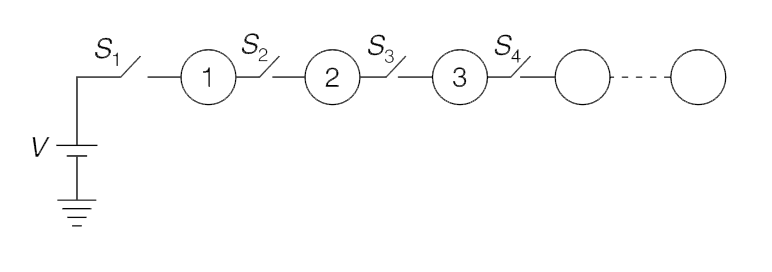
View SolutionWhen you cook food in pressure cooker by placing it over stove, the_______energy changes water to steam.
View Solution
Knowledge Check
To move an airplane through the air, thrust is generated by some kind of propulsion system. Beginning with the Wright brothers' first flight, many airplanes have used internal combustion engines to turn propellers to generate thrust. Today, most general aviation or private airplanes are powered by internal combustion (IC) engines, much like the engine in your family automobile. When discussing engines, we must consider both the mechanical- operation of the machine and the thermodynamic processes that enable the machine to produce useful work. We consider the thermodynamics of a four-stroke IC engine.
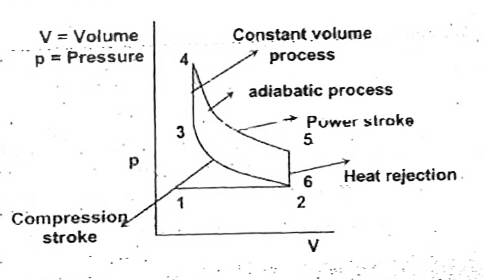
Figure shown represents such a cycle which is used in all Internal combustion engines. The figure shows a p-V diagram of the cycle. Using the engine stage numbering system, we begin at the lower left with Stage 1 being the beginning of the intake stroke of the engine. The pressure is near atmospheric pressure and the gas volume is at a minimum. Between Stage 1 and Stage 2 the piston is pulled out of the cylinder with the intake valve open. The pressure remains constant, and the gas volume increases as fuel/air mixture is drawn into the cylinder through the-intake valve. Stage 2 begins the compression stroke of the engine with the closing of the intake valve. Between Stage 2 and Stage 3, the piston moves back into the cylinder, the gas volume.decreases, and the pressure increases because work is done on the gas by the piston. Stage 3 is the beginning of the combustion of the fuel/air mixture. The combustion occurs very quickly and the volume remains constant. Heat is released during combustion which increases both the temperature and the pressure, according to the equation of slate. Slage 4 begins the power stroke of the engine. Between Stage 4 and Stage 5, the piston is driiven towards the crankshaft, the volume in increased, and the pressure falls as work is done by the gas on the píston. At Stage 5 the exhaust valve is opened and the residual heat in the gas is exchanged with the surroundings. The volume remains constant and the pressure adjusts back to atmospheric conditions. Stage 6 begins the exhaust stroke of the engine during which the piston. moves back into the cylinder, the volume decreases and the pressure remains constant. At the end of the exhaust stroke, conditions have returned to Stage 1 and the process repeats itself. During the cycle, work is done on the gas by the plston between stages 2 and 3. Work is done by the gas on the piston between stages 4 and 5. The difference between the work done by the gas and the work done on the gas is the area enclosed by the cycle curve and is the work produced by the cycle. The work times the rate of the cycle (cycles per second) is equal to the power produced by the engine.
Choose.the correct statement.ADuring the compression stroke, the gas does positive work.BDuring the power stroke the gas.does positive work.CBetween stage 1, 2, the work is done on the gas.DNone of the above.To move an airplane through the air, thrust is generated by some kind of propulsion system. Beginning with the Wright brothers' first flight, many airplanes have used internal combustion engines to turn propellers to generate thrust. Today, most general aviation or private airplanes are powered by internal combustion (IC) engines, much like the engine in your family automobile. When discussing engines, we must consider both the mechanical- operation of the machine and the thermodynamic processes that enable the machine to produce useful work. We consider the thermodynamics of a four-stroke IC engine.
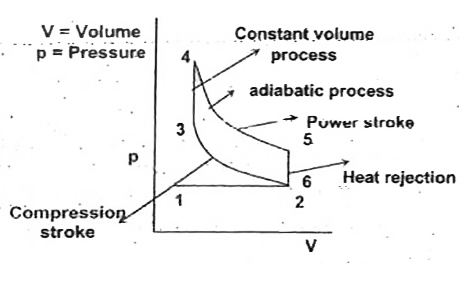
Figure shown represents such a cycle which is used in all Internal combustion engines. The figure shows a p-V diagram of the cycle. Using the engine stage numbering system, we begin at the lower left with Stage 1 being the beginning of the intake stroke of the engine. The pressure is near atmospheric pressure and the gas volume is at a minimum. Between Stage 1 and Stage 2 the piston is pulled out of the cylinder with the intake valve open. The pressure remains constant, and the gas volume increases as fuel/air mixture is drawn into the cylinder through the-intake valve. Stage 2 begins the compression stroke of the engine with the closing of the intake valve. Between Stage 2 and Stage 3, the piston moves back into the cylinder, the gas volume.decreases, and the pressure increases because work is done on the gas by the piston. Stage 3 is the beginning of the combustion of the fuel/air mixture. The combustion occurs very quickly and the volume remains constant. Heat is released during combustion which increases both the temperature and the pressure, according to the equation of slate. Slage 4 begins the power stroke of the engine. Between Stage 4 and Stage 5, the piston is driiven towards the crankshaft, the volume in increased, and the pressure falls as work is done by the gas on the píston. At Stage 5 the exhaust valve is opened and the residual heat in the gas is exchanged with the surroundings. The volume remains constant and the pressure adjusts back to atmospheric conditions. Stage 6 begins the exhaust stroke of the engine during which the piston. moves back into the cylinder, the volume decreases and the pressure remains constant. At the end of the exhaust stroke, conditions have returned to Stage 1 and the process repeats itself. During the cycle, work is done on the gas by the plston between stages 2 and 3. Work is done by the gas on the piston between stages 4 and 5. The difference between the work done by the gas and the work done on the gas is the area enclosed by the cycle curve and is the work produced by the cycle. The work times the rate of the cycle (cycles per second) is equal to the power produced by the engine.
Consider that the above diagram represents an ideal such cycle then choose the incorrect statement fora corresponding real cycle.AThe area of the p-V diagram for the real cycle will be lesser than that for ideal cycle.BThe shape of the p-V diagram for the real cycle will be similar to the corresponding ideal cycle.CThe power produced by the engine for an ideal cycle will be greater than that produced by corresponding real cycle.DThe shape of the p-V diagram for the real cycle will not be similar to the ideal cycle.
Some water in a tin with a lid which can be tightly screwed on its open mouth. The water is heated to boil and the steam from boiling water is allowed to escape for some time. The open mouth is sealed with air-tight cap and the can is cooled under tap-water. The sides of the can are crushed and get deformed.
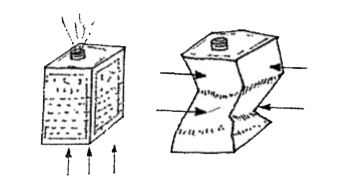
View Solution(a) (i) Ethyl mercaptan
(ii) Strong smell of ethyl mercaptan
(b) Diffusion (in gases)
(c) The spreading out and mixing of a gas with another gas due to the motion of their particles is called diffusion in gases
(d) The leaking cooking gas containing the strong smelling substance ethyl mercaptan spreads and mixes with the surrounding air by the process of diffusion. When the air containing ethyl mercaptan reaches our nose, we can smell it and come to know of the gas leakage.
(e) LPG is a highly inflammable gas (which catches fire very easily). If Mrs. Chopra had continued to use the leaking LPG cylinder, then a lot of LPG would have collected in the kitchen after some time. This collected LPG could ignite on coming in contact with gas stove flame causing a big fire in the kitchen. Even the LPG cylinder could catch fire and burst causing a big explosion. This could lead to the loss of life and property.
(f) The various values displayed by Vibha in this episode are (i) Good smelling power (so as to smell leaking cooking gas even from a distance) (ii) Knowlege of tshe risks of using a leaking LPG cylinder (iii) Responsible citizen (in calling LPG distributor to rectify gas leakage), and (iv) Desire to protect her family and property (from any related accident).
View SolutionWhen a liquid kept in a close vessel is exposed to atmosphere, the vessel never becomes dry. But if the same liquid is kept in an open vessel, it dries up afte some time. Explain
View Solution5.00 kg of liquid water is heated to 100.0∘C in a closed system At this temperature , the density of liquid water is 958 kg/m3 . The pressure is maintained at atmospheric pressure of 1.01×105 Pa. A moveable piston of negligible weight rests on the surface of the water. The water is then converted to steam by adding an additional amount of heat to the system. When all of the water is converted, the final volume of the steam is 8.50m3. The latent heat of vaporization of water is 2.26×106 J/kg.
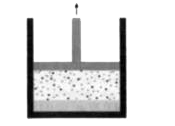
How much heat is added to the system in the isothermal process of converting all of the water into steam?
View Solution5.00 kg of liquid water is heated to 100.0∘C in a closed system At this temperature , the density of liquid water is 958 kg/m3 . The pressure is maintained at atmospheric pressure of 1.01×105 Pa. A moveable piston of negligible weight rests on the surface of the water. The water is then converted to steam by adding an additional amount of heat to the system. When all of the water is converted, the final volume of the steam is 8.50m3. The latent heat of vaporization of water is 2.26×106 J/kg.
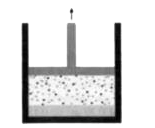
How much work is done by this closed system during this isothermal process?
View Solution5.00 kg of liquid water is heated to 100.0∘C in a closed system At this temperature , the density of liquid water is 958 kg/m3 . The pressure is maintained at atmospheric pressure of 1.01×105 Pa. A moveable piston of negligible weight rests on the surface of the water. The water is then converted to steam by adding an additional amount of heat to the system. When all of the water is converted, the final volume of the steam is 8.50m3. The latent heat of vaporization of water is 2.26×106 J/kg.

What is the change in the internal energy during this isothermal process?
View Solution
